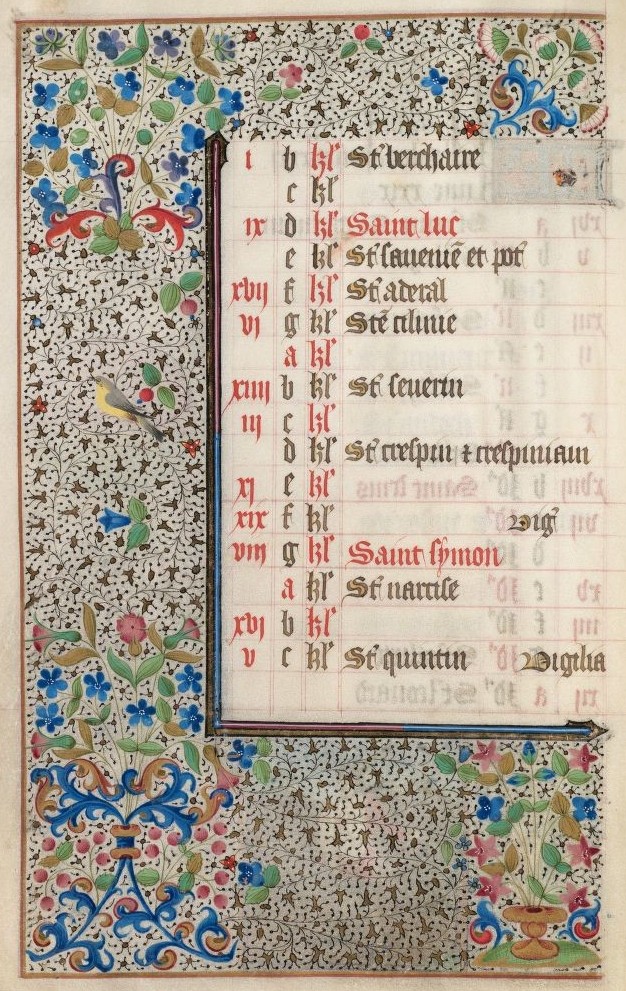A slew of Spanish Hours are coming in the near future, thanks to the detailed catalogue information in Josefina Planas’. Horae: el poder de la imagen : libros de hores en bibliotecas españolas. (Madrid: Orbis Mediaevalis, 2016). These are mostly not actually Spanish-made manuscripts, sadly, but a broad spectrum of French, Flemish, and Italian MS that are presently held in Spanish collections.
The first of these to be added is from the Biblioteca Nacional de Espagna, Vitr 23 10. This 13th C Parisian book is known as the Clinton Book of Hours, from the 15th C british owners. This manuscript starts with a long pictoral sequence, depicting two scenes of St. Edward the Confessor and then the life/death/resurrection of Jesus, leading to the calendar starting on f.29v.
The calendar itself is not graded, it uses gold and blue ink without obvious pattern. There is a tendency for lone important feasts to be gold, but when entries cluster they fall to simple alternation. Outside the main entries there are some of the Zodiac signs, 5 months, and many of the other informational notes (dates for easter and Rogation Keys). There are also several obituaries for members of the Clinton family in a later hand, in brown ink. The main entries are rather sparse, 142 dates populated, and most are the basic Parisian saints. With the exception of a row shift at the beginning of October(see f.37v below), the entries are accurate with only one incorrect entry elsewhere.
(DB Id: 279)
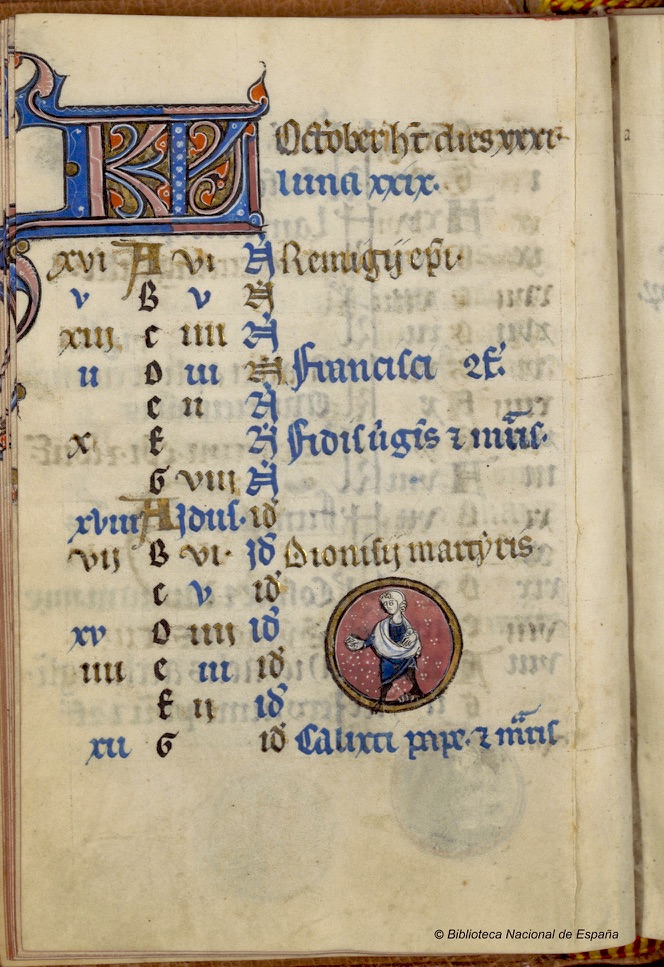
Back to the Morgan Library for M.493, the Morgan Black Hours, so called because they are written in silver and gold in on black-stained parchment. The bad news is that this treatment makes the illumination, particularly the colors, very fragile and prone to flake off. The good news is that means this is one of the few books at the Morgan that has been fully digitized. As is common, the style of the illumination seems to derive from the work of Willem Vrelent.
The calendar is sparse, with only 111 entries across the span of the year, nearly 1/2 of those (52) in gold for high importance. With that few entries it is harder to draw any conclusions from the calendar, but Bishop Donatiani (of Reims) (See October f.11r below) appears in gold, which seems unique to Flemish manuscripts.
(DB Id: 218)
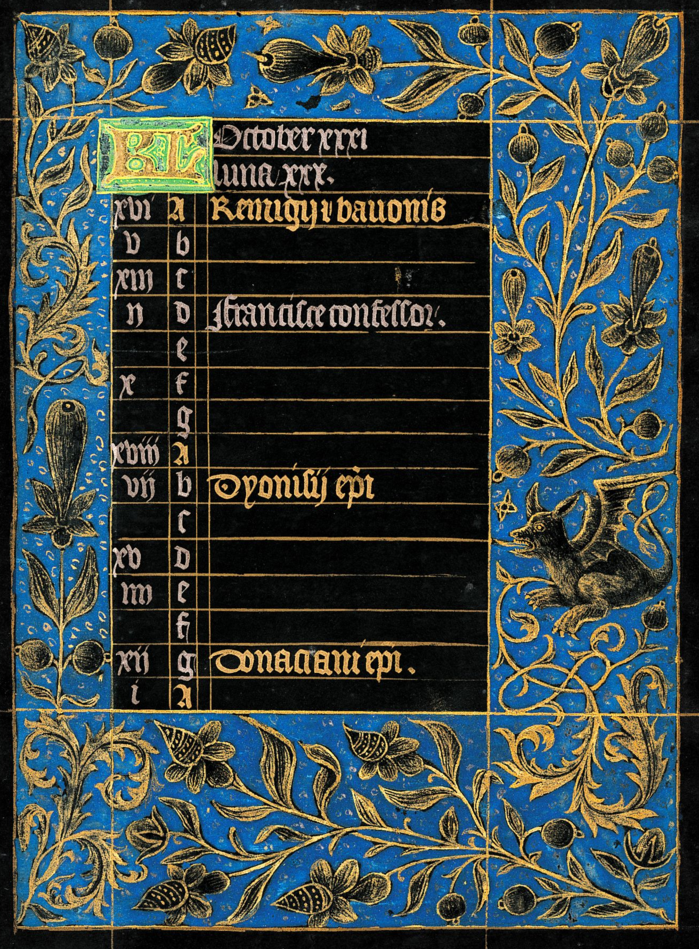
With Walters Art Museum W.186 we are back to manuscripts from the circle of Willem Vrelant. This is a lovely book, the multiple illustrations of angelic musicians are rightly famous, with, as is sadly common, a rather undecorated calendar. There’s no illumination on the calendar except the KL at top, even the space for the more decorated ‘A’ in the dominical letters is unfilled. In the dominical letters there’s also a duplicate, the G for July 15 is written at the bottom of f.7r and the top of 7v.
The most interesting bit, however, is the beginning of the month of October(see f.10r below). The usual saint for October 1, Bishop Remigius of Reims, has been pushed to October 2. Listed on October 1, in red, are Sts. Bavo, an unusual but by no means unique saint for that day often seen in Dutch and Flemish manuscripts, and St. Gaidii. The catalogue interprets this as a variant of Aegydius, but the usual day him is September 1, and I’ve found no reference to a variant date of October 1. For now I am leaving this entry untagged, hopefully another example will come along and help clarify things
(DB Id: 209)
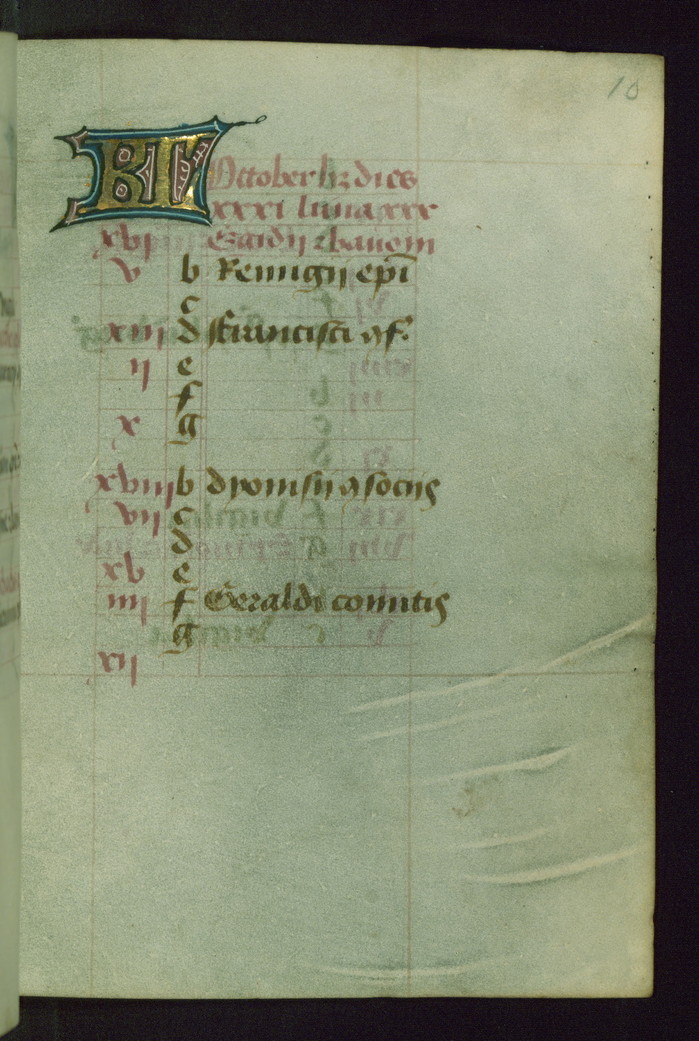
Bibliothèque nationale de France Nouvelle acquisition latine 3093 is one of the multiple fragments of a complex manuscript, which was owned and possibly comissioned by Jean, Duc de Berry (yes, that Duc de Berry). The BnF fragment, called the Très Belles Heures de Notre-Dame, is mostly Book of Hours content, but the manuscript originally contained a Psalter and some of a Missel as well. Even without touching on the complex history of creation and illumination, the calendar is interesting in it's own right. The entries are mostly standard for Paris, though there are a large number of local bishops specified with their See, (see Sts. Savian and Potencian, October 19, on f.Vv below. Their see of Sens is recorded). There are also some of the specifically Parisian royal feasts, including both the Crown of Thorns (Aug. 11) and Relics of St. Chapelle (Sept. 30) and multiple kings and queens.
The coloring seems to have no pattern at all, sadly. There are 4 colors used, red, blue, pink (distinct from the red, perhaps a faded purple) and black, which might be lost gold, and many of the feasts have size indications in the right margin (3 or 9 lessons, or Annuale), but there seems to be no correlation between color and rank. High-rank feasts are often blue, but in November, where the month is mostly full, it seems to be a simple pattern (blue is roughly every 3rd feast), and St. Andrew, an apostle, is pink.
(DB Id: 197)
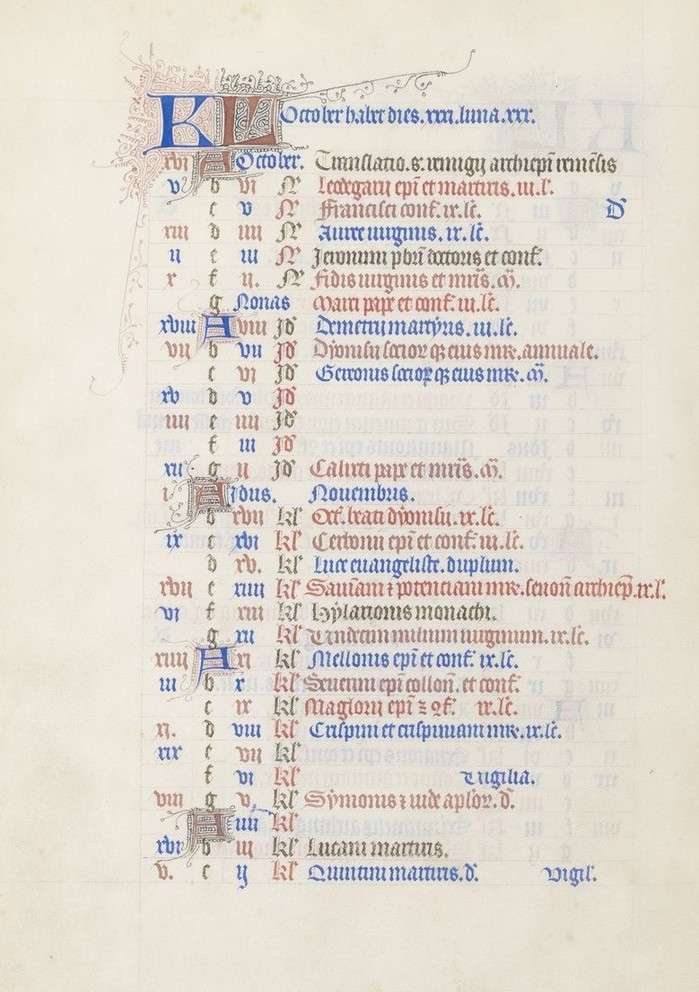
Another Use of Paris Book of Hours from the 15th Century, Boston Public Library MS q.med 82 is a nice, if not spectacular manuscript. The calendar is complete, and has a higher-than-usual number of errors (23), but not nearly as many as the recently added MS. 1841 (DB ID: 116). The calendar is complete except for a missing entry on October 21(see f.10v below), where Ursula and her 11,000 martyrs probably should have been.
(DB ID: 163)
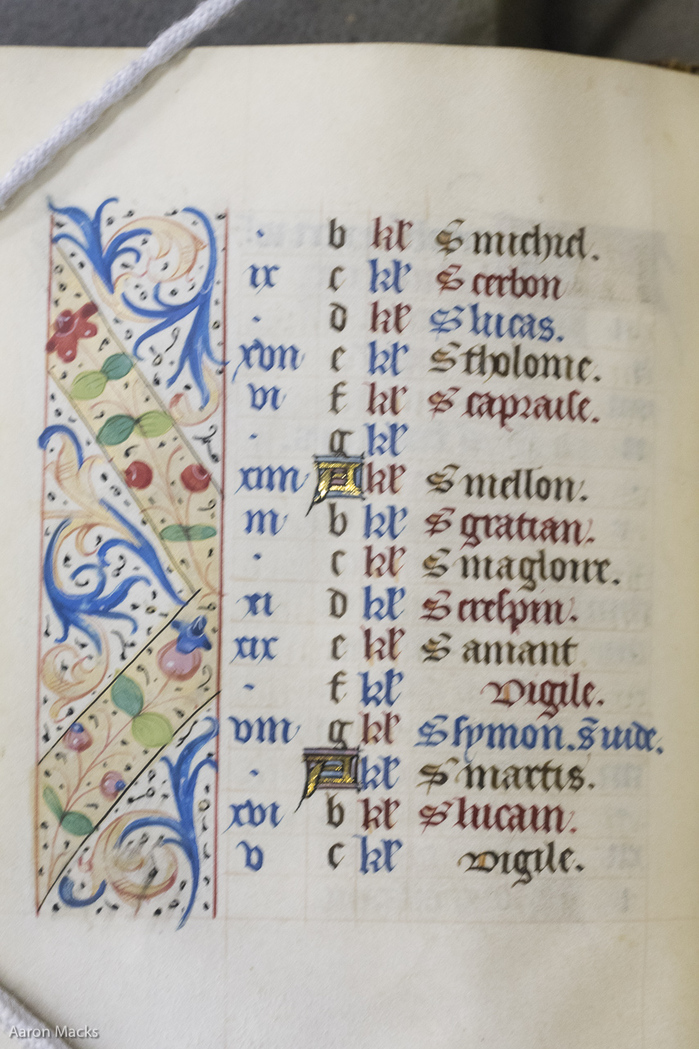
(Photo is mine, from the reading room, hence the low quality
At first blush Harvard's Houghton Library ms Lat 132 is a somewhat unremarkable Use of Rome Hours from Bruges. Though it has 12 lovely miniatures in the style of the "Gold Scrolls group", the calendar is rather boring, red and black with red strikethroughs for medium-importance days like vigils. It was updated at least 2 seperate times, with a second hand writing in black Gothic similar to the original and a third hand in a later batarde . Hidden in it, however, is an interesting clue to the literacy of its owners, October 9th(see f.Fv below). Written in red, this is the Feast of St. Denis, patron of the eponymous cathedral just north of Paris and the martyr for whom Montmartre is named. Denis is a adaptation of his actual Greek/Latin name, Dionysus. The first scribe wrote Dyonisi Epi (Dionysus Bishop), as expected for a calendar in Latin, but the second scribe appended "S. Denis", either not understanding that they are the same, or for a patron who might not know the Latin.
(Link to the DB: 135)
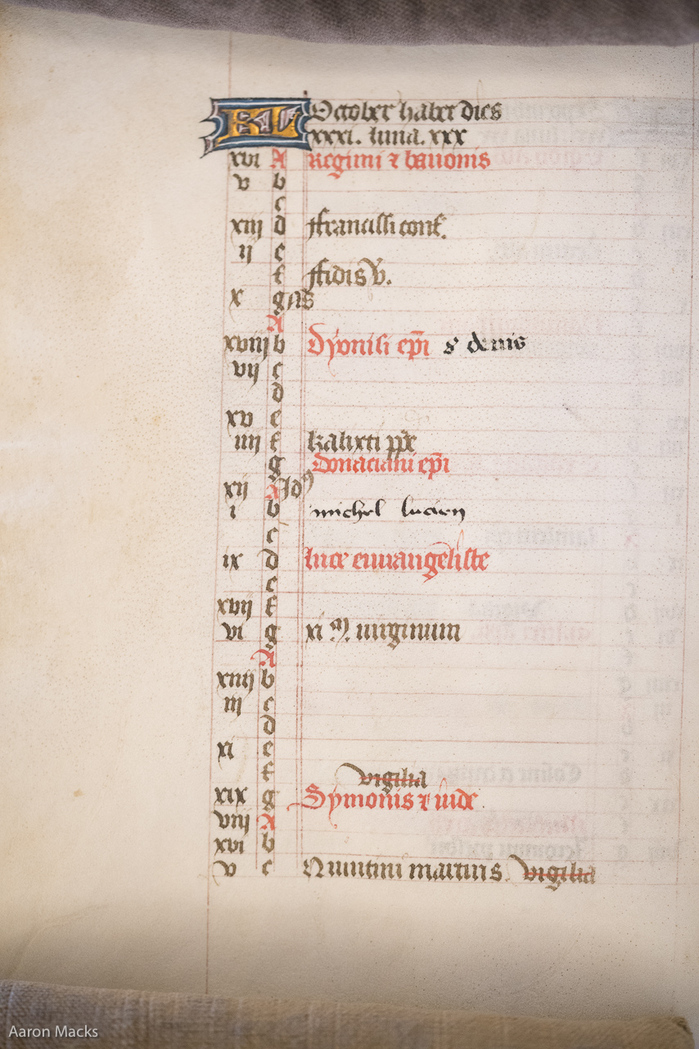
Bibliothèque nationale de France Nouvelle acquisition latine 3209 is another slightly odd, recently acquired Book of Hours. This one is Use of Rome, but calendar specific to Autun, and dated to right around 1450-1460. The calendar has several very specific-to-Autun entries, such as the “Revelation to St. Lazarus” on October 20(see in red f.5v below) and the “Dedication of the Church of St. Lazarus” on December 30th. The Cathedral of Autun is dedicated to St. Lazarus and has many of his relics, though in the early Middle Ages there was some confusion as to which Lazarus they had. This calendar is also somewhat unusual in calling out the Egyptian Days, which were thought to be especially inauspicious (see Oct 3 and 23). (See in the DB: 143)
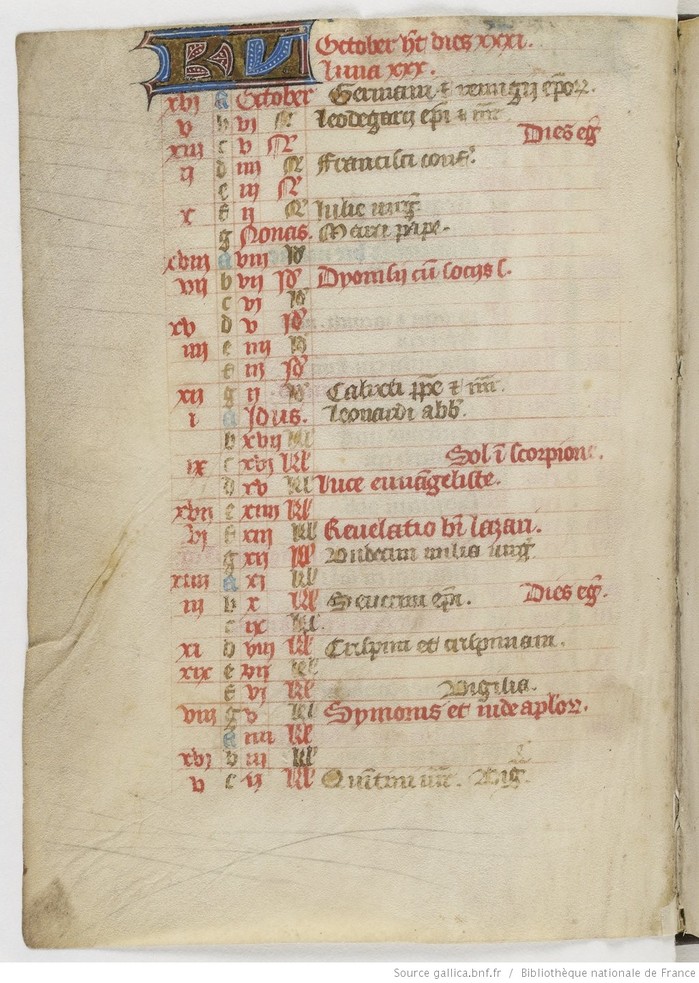
Another manuscript from the Richardson collection at Harvard's Houghton Library, Richardson 9 is a northern book, Use of Rome, from circa 1500, written in a very practiced Batarde hand. There are remarkably few errors in the completely-populated calendar and although it is not listed as such in the catalogues, the signs point to Bruges as the source of the calendar. The start of October (f.12v below) shows an interesting listing on the 3rd, Sts. Ewald and Ewald, 2 priests who died on the same day, are listed as "Duorum Enwaldorum", "The Two Enwalds"
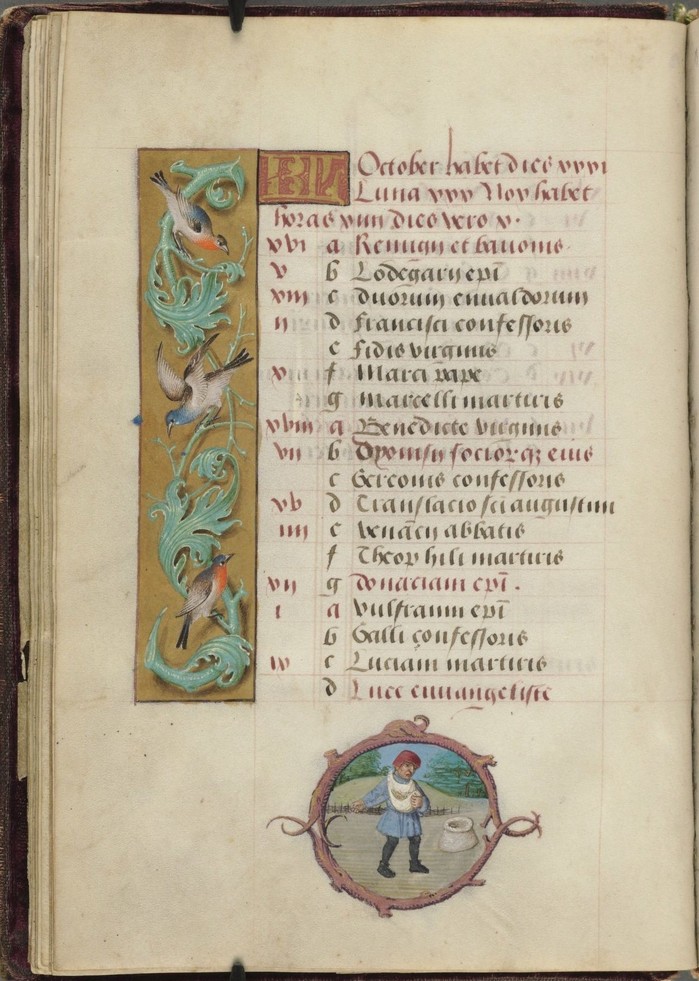
From the Richardson Collection at Harvard's Houghton Library comes MS Richardson 7, a lovely book from the Troyes/Sens area. The foliate decorations are more complex than many and very well executed, with an unusually accurate calendar. I was only able to detect 4 errors in copying out of 203 saints. Pictured is the second half of October with St. Simeon unusually alone, he is almost always listed with St Jude
